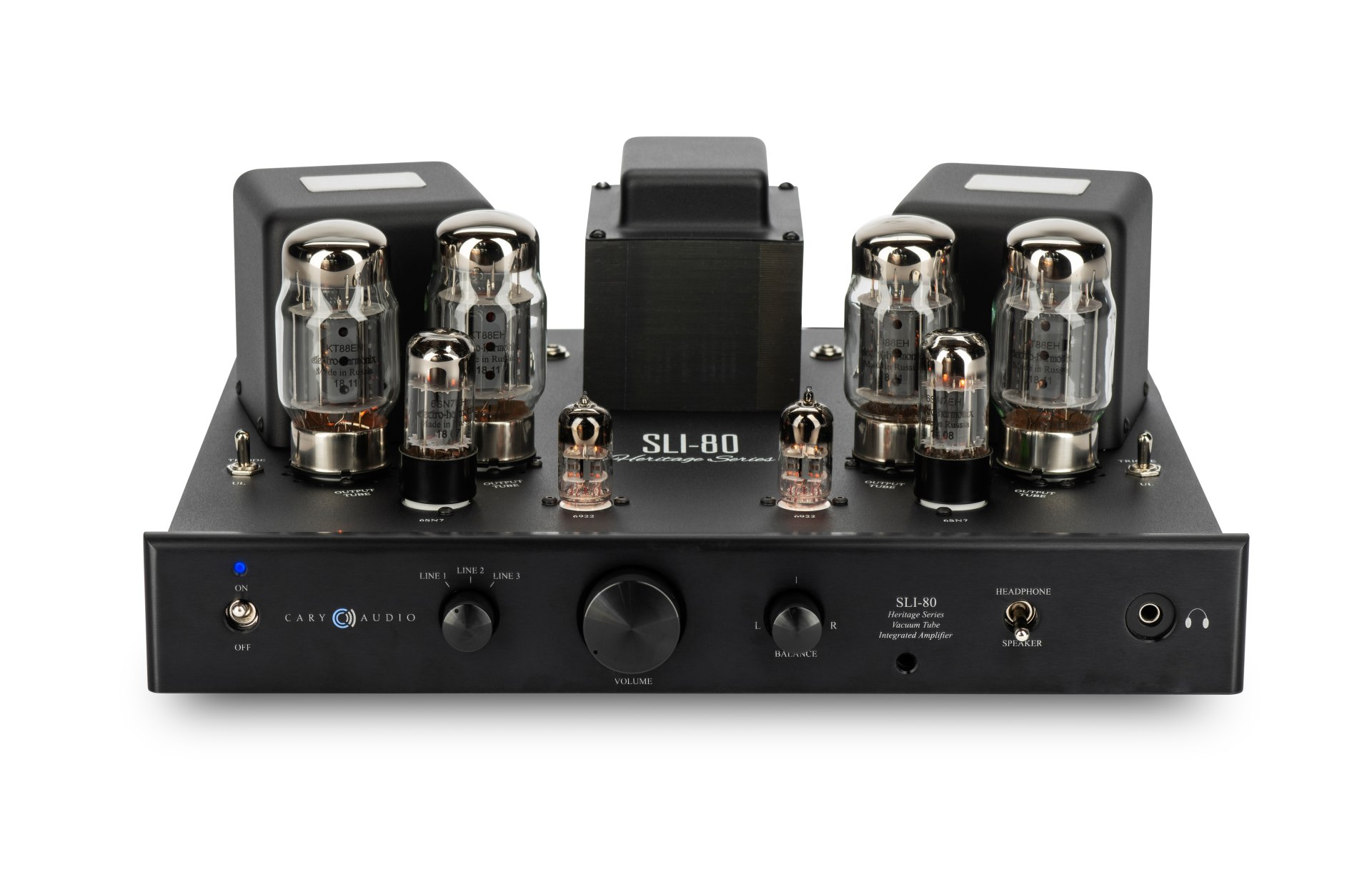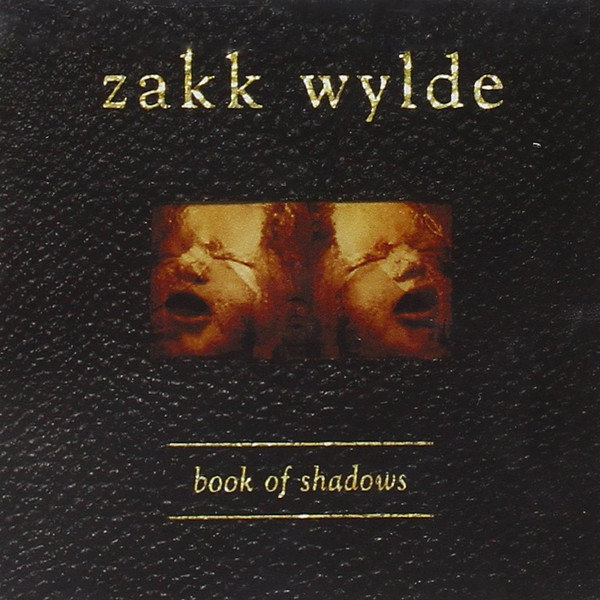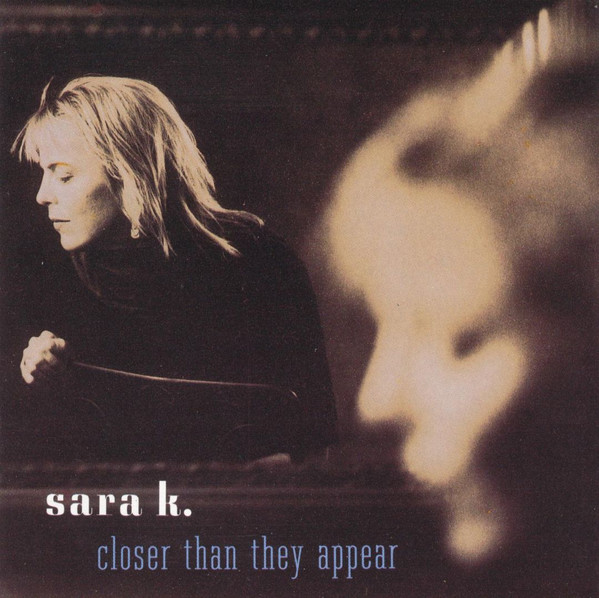Douglas Moore compares Cary’s tube amp to the competition and gives his thoughts about domestic versus Chinese-made gear with advantages and pitfalls following both choices. Douglas also observed: ‘Equally at home with different types of music the Cary Audio SLI-80HS tube amp is a fair indicator of which direction the ‘tube magic’ is going today’. The original review is to be found at Sound Advocate website, although here we offer most of it to read too.
The Cary Audio SLI-80HS tube integrated amplifier cuts a wide swath in the high end tube amplifier world!
Tube amplifiers are something of a mystical creature to some people. When I was coming of age as an audiophile and learning this new and exciting world it was the mid 80’s. At that time we had just gotten over the receiver wars of the late 70s and early 80s and it seemed that solid-state amplifiers had taken over for good. I did not know too many people still running tube amplifiers except a few holdouts from the 60s that would only use a tube design. I would see the occasional system with an old Dynaco or Marantz tube amp but that was it.
You see the thought in the 80s with speakers seemed to be going in a direction of smaller cabinets, and smaller less sensitive drivers. The more complex crossovers also cause a change in the sensitivity of speakers. Many speakers from the 80s and 90s are designed this way and have a sensitivity that hovers around 85 to 90 dB. Most tube amplifiers then and now are power limited unless they are hugely overbuilt, very large, and quite expensive. So, initially—my only real exposure to tubes was during my electric guitar playing days.
However, many audiophiles feel there is a special magic that happens in high-end home audio when a tube amplifier is introduced into the chain. As I can appreciate the good in both solid-state and tubes, when I review a component, I listen for its quality period regardless of topology. This review encapsulates a tube amplifier and it just so happens to be a world-renowned one at that.
Cary Audio was founded in 1989 by Dennis Had. And while he is no longer with the company his designs still represent the hallmark of the company. While tubes were not huge at this time, they did have a devoted following of tube diehards that would not accept anything else for their systems.
Even though paper tube amplifiers will never measure as well as a well-designed solid-state unit, many people are not concerned with these slightly worse measurements. They only care about the sound quality and emotional connection they have with the music. I do mostly agree, the average quiet noise floor in most listening rooms is between 28-30db. Within this noise floor, you will most likely never hear any distortions in any well-designed amplifier today.
I sometimes laugh at the “measurement is everything” crowd because they will trade up amplifiers when they find the next newest amplifier that has even .001 or less difference in distortion. Believe me, there are many more things to worry about in choosing an amplifier, or any component for that matter. I think these people need to spend more time enjoying music and less time doing measurement drag races!!
The Cary SLI-80HS is Cary’s entry-level product price wise but there is nothing entry-level about it. This amplifier is designed and built the old-fashioned way. Cary uses very good components (some of them designed especially for them) and techniques to ensure a fine-sounding product. The SLI-80HS is hand wired and there is no circuit board to be seen. While some people will say that this will add more distortion (the measurement police!) I will tell you a story to assure you the hand wiring has its place.
Years ago, I was at a guitar shop listening to some new Fender amplifiers they had come out with. They had an amplifier model that was available in a circuit-board-designed model and a fully hand-wired model. The Fender happened to be there and he wanted me to play through both models. With my trusty Japanese Fender Stratocaster, I proceeded to play. The hand-wired design easily beat the circuit-board design hands down. Better tonality, better midrange, and just an overall more musical sound. So, trust me when I say that hand-wired amplifiers have their merits.
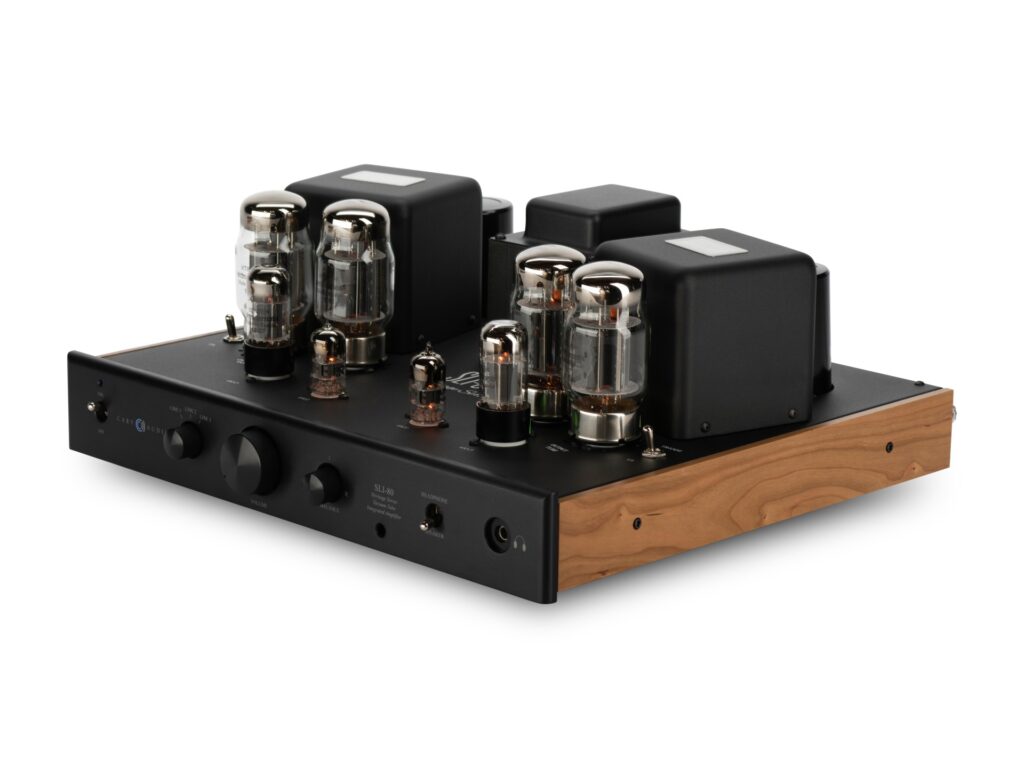
THE SLI-80HS AMP
The SLI-80HS is sold with several options available. There is a black faceplate like the above and a silver faceplate. Also, there are side plates in Walnut (like above), Cherry, and black ash. Mine was the black faceplate with the Walnut side plates and looked great. Build quality was as good or better than any tube amplifier I have personally seen. The packaging is very well put together and sturdy (as you would have to) to ship a tube amp without the tubes breaking.
The SLI-80HS is like having two amplifiers in one chassis. It can do class A triode mode at 40 watts per channel and class A/B ultra-linear mode with 80 watts per channel into 4 or 8 ohms. The tube complement from the factory is 2-6922 input buffer tubes and 2-6SN7 pre-driver/phase inverter tubes. For power tubes, Cary chose the KT88 and has 4 total (2 per channel).
One of the cool things with tube amplifiers is that you can tube roll, meaning that not only can this amplifier use KT88 tubes but the amplifier also run 6550, EL34, 6CA7, KT77, KT90, and KT120; thus, giving the end user many options to reach the sound profile and characteristics that they desire. I liked that they chose the KT88 tubes as I have always enjoyed them. To me, it gives a robust frequency response while remaining cleaner than some other tubes. Also, there is no roll-off in the high frequencies (at least with the SLI-80).
Anyone with any knowledge of tube amplifiers knows that the tubes are only one part of the equation to how good an amplifier sounds. And the SLI-80HS has you covered there as well. The output transformers are very important in tube amplifiers. Tubes by themselves output at very high impedances that are not compatible with driving speakers. These transformers step down the impedance to output a signal more in line with the speakers that they will drive. The output transformers that are specially designed by Cary just for the SLI-80HS are much better than just throwing an off-the-shelf transformer that fits the spec in there. This ensures both constant reliable specifications and better overall sound. There is a negative feedback circuit that is there to reduce noise and improve speaker dampening, this being only 4db.
The Cary has no coupling capacitors in line with the input signal. Solid-State rectification is utilized to produce a good pace to the music and allows better dynamics and bass detail than earlier versions of the SLI-80.
Like most tube amplifiers of this type, distortion measurements aren’t part of their spec sheets so they aren’t mentioned here. You might be able to find someone that has measured it online somewhere but for me, I am much more concerned about the sound quality.
SETTING THINGS UP
Not unusually, the SLI-80HS was a cinch to connect to my system
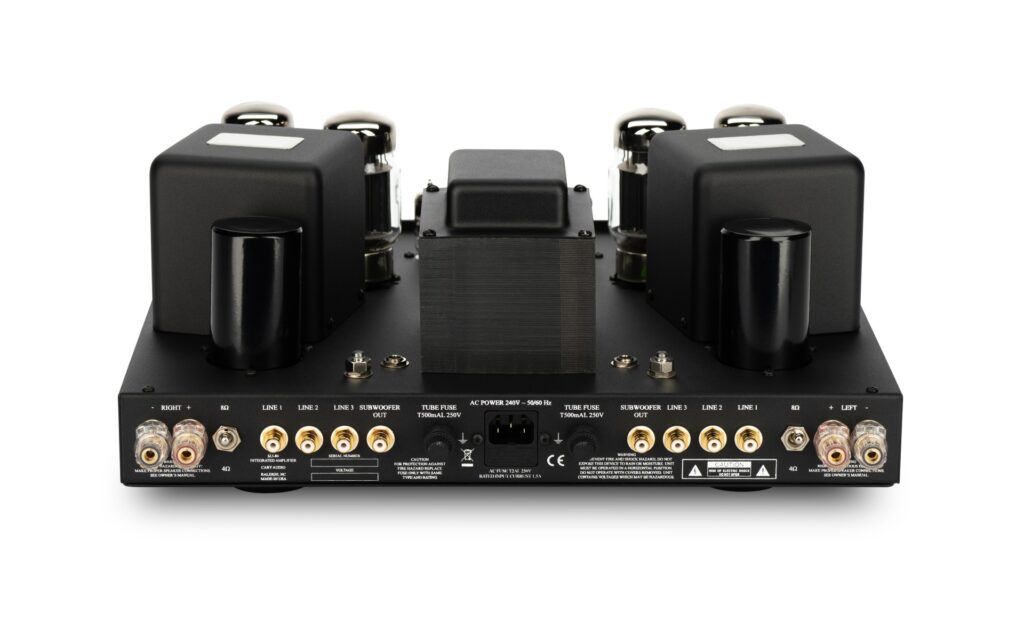
The rear panel is mostly well laid out with the power cord inlet right in the middle. This connector allows you to choose the power cord of your liking. Audio inputs are RCA types only (not balanced) and are split to each side of the amplifier. Then there are the speaker connectors. The connectors used are of high quality and will accept banana or spade connectors. Besides these connectors are the switches for 4 or 8-ohm speakers. Some people will try multiple settings while driving their speakers but I mostly kept to the script and ran with the 4-ohm setting on my Spatial Audio 4-ohm speakers.
The front panel of this amplifier was also well-labeled.

There is a power toggle switch, input selector, center-mounted volume control, Balance control, another toggle switch for amplifier or headphone operation, and finally a ¼” headphone jack.
The SLI-80HS comes with a fully featured remote and this is going to be where my one complaint derives from its operation. This remote is huge! This remote looks more like a home theater universal remote than an integrated amplifier remote. A simple elegant volume remote would be much more usable in my opinion.
After installing the amplifier, I listened to it for a few days just to get acquainted with the unit. It only takes a few minutes to warm up but a while to fully heat up to optimum temperature. I did not feel the need for a long break-in period as Greg from Volti Audio ran the amplifier at his factory for a couple of weeks straight before bringing it to me for review. After a few easy-going days of listening, I settled down to do some serious listening. I did most of my listening in ultra-linear mode since to me it offered the best mix of tube goodness but kept things detailed and tight. I mostly used the triode mode for a singer-songwriter or an instrumental piece because it gives you the most holographic image and tube tonality but you give up a little headroom and dynamics doing so.
Playing the first few songs there was one thing that took me by surprise. While being a fully tube-integrated amplifier, it does not suffer from some of the negative aspects I have heard with some tube amplifiers over the years. The frequency response was full from top to bottom. There was detail and air in the highs that I was not expecting, also bass was full and tuneful with plenty of detail (not a solid-state level of detail and tightness but very good). I think two things are credited for this. The solid-state rectification and the use of KT88 tubes. I am quite sure that using a different type of tube would bring forth a different outcome.
THE AMPLIFIER’S SOUND
I am not a person that uses only “audiophile” music to review a piece of gear. When I review, I also incorporate music from different genres that the end user might find themselves familiar with. I will use audiophile tracks on my review track list to listen for certain aspects of the sound, but I like to mix it up with other music to give the review a real-life musical [foundation].
The first album I chose was Zakk Wylde’s Book Of Shadows. While not everyone’s cup of tea, I know this album well. The Cary SLI-80HS allowed this album to shine and played well through both the Spatial Audio M3 TS and Volti Audio Jazz speakers I had on hand.
Although the bass while not the tightest I have heard did deliver great tone and impact. The highs were well-balanced and detailed without glare or roll-off. The soundstage and imaging were right where this album is mixed to be. Tube amplifiers exhibit soundstage a little differently than other amplifiers and that is what most people love about them. The stage seems to levitate out from the speakers and Zakk’s guitar solos seemed to almost reach out and touch you with the Cary. The image depth was good as well. This whole album is a good source to just sit back and enjoy the Cary sound.
South For Winter Acoustic Sessions is another great acoustic album to test audio gear with. It is recorded well and can sound astoundingly real on a good system. My favorite song off the album is Ten Black Crows. This song has a beautiful mix of well-recorded acoustic guitars and male and female vocals that spread across the stage in a well-rendered manner that can put tears in your eyes. The SLI-80HS rendered this song beautifully and sounded good in both ultra-linear mode and triode mode. But this is one of the times that triode mode was the preferred setting. The pure class A triode mode was by far the best mode for this album.
When you put the Cary into triode mode It turns into a tube super machine as it will render things like acoustic guitars and vocals with sweet succulent tonality. Sound of this type will make the hardest core of the measurement police second-think their choices. The Cary is a service the music amplifier first in design.
Sara K’s Closer Than They Appear is a Chesky Records release and is an album that every song is an example of some outstanding recording techniques. This album for me has no favorites as it is one you have to play in its entirety. All Chesky Records are like this in that their quality alone is worth a full listen.
This recording through the Cary was lifelike and full-bodied. The Saxophones seemed to burst into the room, while guitars fell into place in the mix. Drums were set back and in their proper place. And Sara’s vocals had great body and emotion. The recording sounded best in the ultra-linear mode with better dynamics and punch while the ultra-linear mode gives you just a touch of solid-state control that this album needs.
Bass: Bass on the SLI-80HS is incisive and solid with good detail. The solid-state rectification helps here. Compared to my reference Pass Labs X150.5 and Hegel P20 preamp the Cary did sound a touch slower and rounder. Driver control was a bit looser than my solid-state reference as well. This is to be expected due to the designs respectively. However, the Cary held its own quite well compared to other tube-integrated amplifiers I have heard.
Midrange: The midrange is where tube amplifiers seem to shine and the Cary was no exception. Vocals were natural and seemed to emanate beautifully between the speakers in the proper space. The instruments had body and detail while never sounding overly saturated. Overall, the midrange was a strong suit of this amplifier.
Treble: This in my opinion was a surprise to me. The treble had detail and did not suffer the roll-off I have heard about in other tube designs. I’m not sure if this was due to the KT88 tubes or a design choice within the amplifier. In its ultra-linear mode, the treble was a little more detailed and resolving while the triode mode was a midrange dream, although the treble deteriorated a touch of detail in my opinion.
Soundstage and Imaging: Soundstage and imaging were spot on, with both the Spatial Audio and Volti speakers showing their stuff and allowing the music to sound real and with fine locational placement. Instrument separation was good and the music just flowed. The sense of space in the music allowed me to hear and feel the venue of the recording as well as my reference gear.
COMPARISONS
I had three amplifiers in my room at the time I listened to the Cary. I had my Pass Labs X150.5 and Hegel P20 combo, and an Enleum Amp-23r (Review Coming). Comparing these different amplifiers proved very interesting indeed as they use very different topologies within their designs. Comparing the Hegel P20 and Pass Labs X150.5 to the Cary SLI-80HS was a game of trade-offs.
While the Cary had that tube holographic presentation that some people crave the Hegel/Pass had a deeper image and wider soundstage. Surprising transparency was very close but the Hegel/Pass combo pulled out the win in subtle detail. However, for overall musical enjoyment, an argument could be made for either setup depending on what your priorities are.
The Enleum Amp-23r was a more riveting comparison. The Enleum is a low-power design putting out 25 watts at 8 ohms and 45 at 4 ohms. This power output is closer to the output of the SLI-80HS. Both of the speakers used in this review are of high sensitivity. The Spatial Audio M3 Turbo S is 94db efficient and the Volti Razz is 97db. As such, volume and drive were not a problem with any of the amplifiers here as I could get well above my reference volume with any of these amplifiers.
Interestingly, The Enleum amplifier is a departure from the average solid-state design and as such it presents music differently (I will go into further detail in my review forthcoming). The Cary and Enleum had a few things in common. Both amplifiers rendered midrange beautifully but in different ways. Cary had that 3-dimensional midrange allowing instruments to bloom into the room in front of the speakers. The Enleum was equally good in the midrange; but not quite as holographic.
Imaging was more anchored on the Enleum while the soundstage went only as wide as the music was mixed to be. The Cary felt larger and wider in its soundstage delivery. These comparisons are more of a lesson in what is important to you versus what is “better”.
CONCLUSIONS:
Over the years I have heard many great amplifiers from all the topologies used today. Cary has always been a tube-focused amplifier company and it shows. They have had solid-state designs but tubes have always been their passion. This is very apparent in their SLI-80HS.
There have been some really good tube amplifiers coming out of China lately and they are giving the Cary some competition. On that, I will say that you may be able to find a tube-integrated amplifier from one of the Chinese companies cheaper. But I seriously doubt you will be able to get the customer service, 3-year parts and labor warranty, and the support that Cary offers.
Being a hand-wired American-made product is something getting harder to find in today’s world and I give Cary credit for that. If you are in the market for a tube-integrated amplifier that can switch between class A and class A/B, allow you to use several different tube types, and sounds exceptionally good, then I have no choice but to give the SLI-80HS a wholehearted recommendation!
The Review System: Speakers: Spatial Audio M3 Turbo S open baffle./ REL T9x subwoofer/ Digital: Denafrips Venus II, / Modified PC-based Music server/streamer. Analog: Vintage Hitachi Turntable, IFI ZEN phono preamp, Audio Technica VM95SH cartridge Amplification: Hegel P20 preamp. Pass Labs X150.5 power amp. Conditioner: PS Audio Quintet. Cables: Iconoclast SPTPC speaker cables, Mogami XLR interconnects, Iconoclast BAV REL subwoofer cable

